The Boys Who Loved Birds
Air Date: Week of March 13, 2015

The European Greenbelt Today passing through agricultural fields (Photo: Klaus Leidorf/BUND Naturschutz; used with permission)
Today, a protected wildlife corridor called the Greenbelt runs through the heart of Europe, along the route of the former Iron Curtain. But as environmental writer Phil McKenna tells Living on Earth’s Helen Palmer, Europe’s great conservation success story began with the friendship of two young birders who grew up on opposite sides of divided Germany.
Transcript
CURWOOD: For nearly half a century the continent of Europe was divided by the Iron Curtain. It was mostly an ideological, but also a physical barrier, a broad no-man’s land bristling with barbed wire, guards, dogs, even landmines. Today it’s a European green belt, a protected haven for wildlife. Its existence is in many ways due to two boys, both avid birdwatchers, who grew up on separate sides of the divided Germany, but through their commitment helped transform a bitter separation into a sanctuary for nature. Writer Phil McKenna tells their story, "The Boys Who Loved Birds", and spoke with Living on Earth’s Helen Palmer.
PALMER: The story you’re telling is basically a story of two boys who loved birds, one on one side of the Iron Curtain, one on the other side of the Iron Curtain, and so there's Kai Frobel and Gunter Berwing. Tell us about these two.
MCKENNA: Sure. They were two young boys both growing up literally in the shadow of the Iron Curtain within a kilometer or so, and they were both mad about birds. And they both, independent of each other, realized that the best place in all of Germany to see birds was in this no man's land between east and west. And it was the one place in the entire East and West Germany that wasn't fully developed in their agriculture, buildings, otherwise just left feral. And they realized that when they went there, or as close as they could get to this no man's land, that they found birds there that they couldn't find anywhere else in their country.
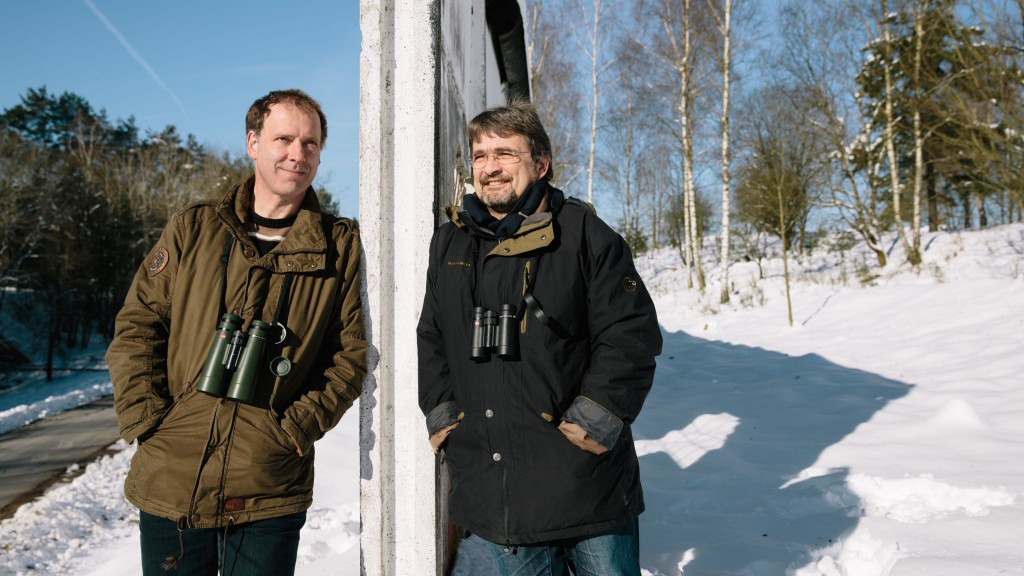
Gunther and Kai today along a section of the former Iron Curtain (Photo: Sven Doering)
PALMER: Well, in fact, you’re right in calling it a no man's land - it was actually kind of a scary place, the Iron Curtain, that went all the way from the Baltic right down across Europe to the Adriatic.
MCKENNA: Incredibly scary, everything from landmines, guards with machine guns, tripwires, electrified fences that would notify the guards if you even touched it. Kai's father was the village doctor and at one point early on when Kai was about 10-years-old, there was a west German farmer who was out raking his field, picking up trash that had come down the river from East Germany, and when he was raking, he raked a landmine and it blew his face apart. The man was quickly taken to Kai's father and Kai was out there with him in the field, as his dad was trying to patch this poor farmer up. That had, as you can image, a tremendous impact on Kai. It gave him nightmares for the rest of his childhood about the wall and about Soviet troops coming over and attacking and going right to his village.
PALMER: But as well as the nightmares about what might come from the east, Kai had this passion for birds.
MCKENNA: Absolutely, and so much so that despite knowing all of the bad things that could come to him if he had to go into the no man's land, he one day, at age 13, was walking along it, realized that he couldn't see any guards from east or west and he was in a particularly wooded section of the no man's land, and he took one last look behind him and he snuck right in. And when he did it completely changed his life. It was like something had never seen before. There were trees that were fallen on the ground, something that he just hadn't seen anywhere else in Germany. It was this very small wilderness.
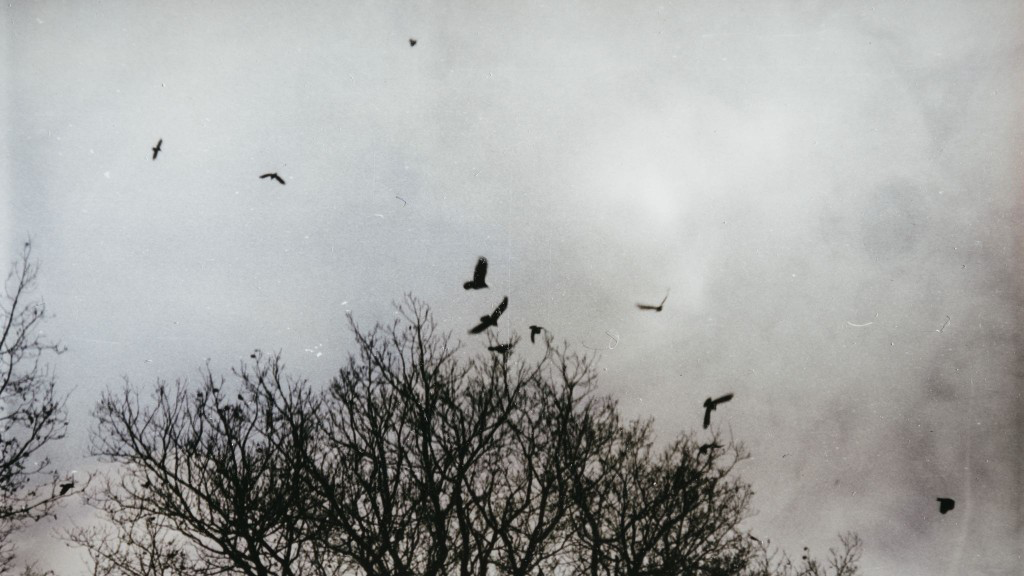
Rooks in the Iron Curtain taken by Gunther Berwing (Photo: Sven Doering/Gunter Berwing)
PALMER: So that's Kai on the west side of the wall. On the east side of the wall or the dividing line, the Iron Curtain, is Gunter Berwing. Tell me about him.
MCKENNA: Gunter. It was fascinating. At exactly the same age, age 13, Gunter, was out riding his bicycle, and he came across this man near the border, and he was pulling this brilliant blue and white songbird, a common House Martin from a net, a mistnet that bird banders use. He was a bird bander and he was out seeing what birds were flying along the Greenbelt, or the Iron Curtain at the time, and that hooked Gunter. So he started going back to this banding station and also started to take a great interest in rooks, this type of crow that would roost in the trees above his home by the thousands each winter. And he very quickly realized that every morning the rooks, the crows, would fly across the border into West Germany, and as a young boy he was very curious, what are these crows doing in the west? And also I think that kind of hit home for him that as a bird they could very easily cross the border, but as a boy he would never have that opportunity.
PALMER: So he saw the rooks flying over into West Germany and what did he think? What did he wonder?
MCKENNA: He wondered what they were doing there, and as luck would have it he had an Aunt, Aunt Nellie, who lived in the west. Turns out she lived in the same village as Kai, and he asked her, he said, "Hey do you know anyone in the west who might be able to tell me what these birds are doing?”And that started this first penpal relationship and then very, very close friendship between the two boys.
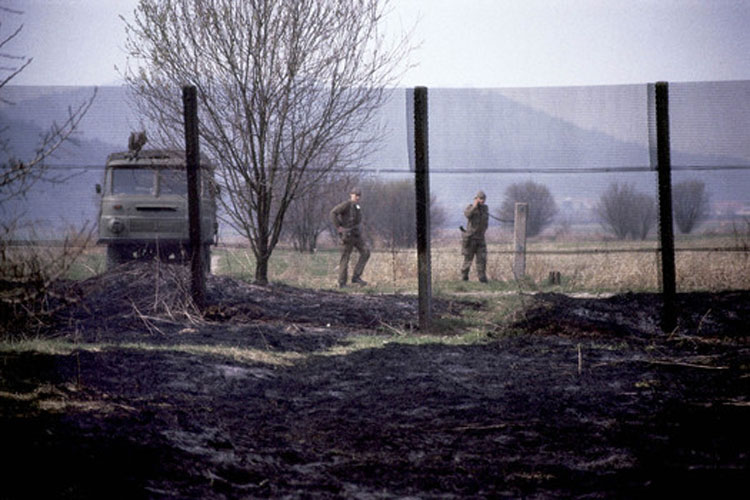
The militarized no-mans-land between East and West Germany (Photo: BUND Naturschutz)
PALMER: So they were basically sharing bird information.
MCKENNA: Exclusively bird information. They quickly determined that the rooks were flying to the agricultural fields of West Germany that were a lot more productive. Turns out, there's a lot more food to eat in the west, even for the birds. And then they moved beyond that, and they started talking about other birds and wildlife in general, always keeping their letters very formal and short, not sure who might else be reading them, and it turns out the Stasi, East Germany’s secret police was reading and keeping a copy of every letter the two exchanged.
PALMER: So fast forward - they did manage to meet a couple times because it was possible to get day passes to go into East Germany if you were West German, not the other way, of course. And so Kai did manage to go over and actually meet Gunter.
MCKENNA: Right. In 1981, Kai, I think was 22 at the time, he was a college student, Gunter was about 15, and it was interesting. He was very nervous for a number reasons going over. Growing up he was always told that this Iron Curtain, it was really like a concentration camp wall. When you get to the other side everybody's got to be starving. It's going to be awful. And he also worried just how is he going to find this boy that he's only ever corresponded with by mail.
PALMER: But it wasn't a problem.
MCKENNA: Right. Right. It turned out that all of his fears were overblown. He was immediately recognized by Gunter because he shows up in a yellow Fiat. He just didn't see cars of any bright color or anything other than the East German’s Trabant in East Germany. He goes up and birding with Gunter and his friends and find that they're very warm. They speak the same language, but the phrases that they use are all a bit different and a bit kinder, and it seems to make the whole thing work.
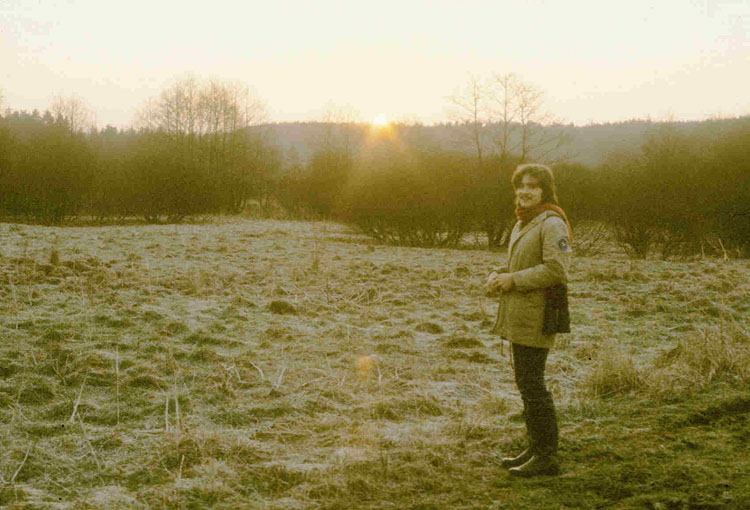
A photo of Kai Frobel as a young man at the border with East Germany (Photo: BUND Naturschutz)
PALMER: OK. We need to get back a little bit. So they meet across the wall. They get together now and again when they get these passes. And then, suddenly, to everyone's surprise it seemed, in 1989, the 9th of November, the wall comes down and suddenly there's free passage. Quite apart from being excited about the fact that this divided country was going to be united again, they realized that there's a real danger. What is their revelation when the wall comes down and everybody's joyous?
MCKENNA: Right. Right. It was immediate. At the time Kai was working for BUND Naturschutz which is this conservation organization in Germany based in Bavaria and they immediately realize, Kai and his boss, that if we don't act quickly, the no man’s land limiting the two countries is going to disappear, it's going to be developed into roads, buildings, agricultural land. We have to preserve this tiny spot that has existed for nature and keep it as such. So, within a month, literally one month from November 9, December 9, they organize a meeting between East and West German conservationists. They had no idea who would come, but 400 people came and at that meeting they announced their plans to have this European, or at the time, German greenbelt, asked everyone in attendance if they supported it, and unanimous support, hands shot into the air. Everyone was in support of it, and the German greenbelt was born.
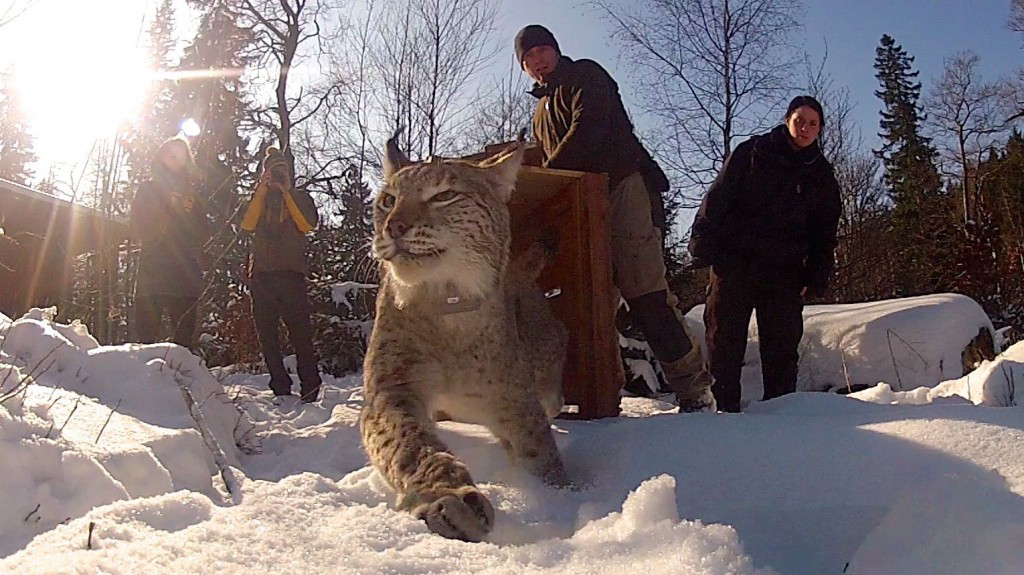
A lynx being released into Harz National Park in Germany (Photo: Harz Lynx Project)
PALMER: So it was born, but, of course, it didn't happen tonight. There was a problem because there were farmers who wanted to reclaim the land that had been taken away for the strip of the wall that was the Iron Curtain. And obviously, people wanted to make links across it, so how did they manage?
MCKENNA: Right. Right. And not only that, but everyone wanted to immediately erase any trace of the Iron Curtain, this very hideous symbol of the division between Germany. They also wanted to make it farmland, make it look like no one had ever been there. So they were fighting against that. The German government also subsidized farmers to buy back their land at a quarter of the price that it had previously been. Yet, in spite of that, largely through Kai and Gunter’s work and the work of many many others, they've been able to protect the vast majority of the Greenbelt - 87 percent of the Greenbelt is still undeveloped space today.
PALMER: They listed an unlikely ally in Mikhail Gorbachev, the ex-Russian President.
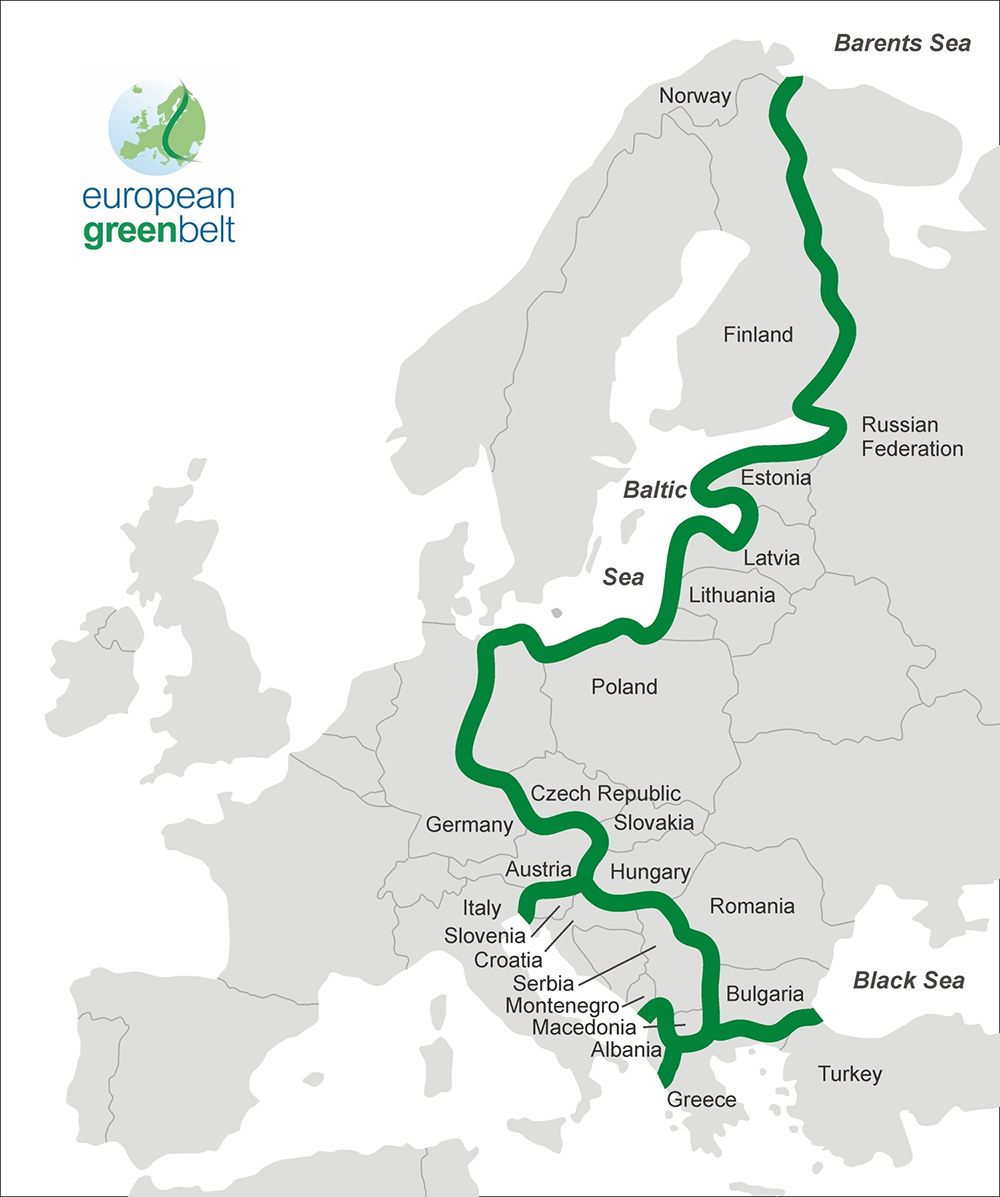
Greenbelt route (Photo: Smaack; wikimedia CC BY 3.0)
MCKENNA: Exactly. And this was a brilliant move orchestrated by Kai's boss, Hubert Weiger. Gorbachev was coming to the inner German border for an art exhibit opening. So there were a lot of German politicians who were going to be there, and at the very last moment on the train as Kai and Hubert are headed to this opening, Hubert says, "Kai, we're going to expand beyond the German greenbelt and we're going to make a call for a European greenbelt, 12,500 kilometers - nearly 8,000 miles long - running from north of the Arctic Circle down to the Black Sea. What do you think?" And Kai was furious. He said, "You've got to be kidding me. I'm in way over my head." He only had one colleague helping him working on the greenbelt and they were struggling just to make it happen in Germany. Now his boss says we're going to expand it tenfold. But then Hubert did something that was brilliant. At the meeting, he's giving his speech and he says to Gorbachev, not only “what you think about this?” but also, “Gorbachev, would you be the patron of this?" And Gorbachev is on the spot. Of course the only thing he could say was “yes”. So he does and though his role was very symbolic, it gave a tremendous boost to both the German and the European greenbelt.
PALMER: So, fast-forward to now. We have as you say, 87 percent of what was this former death strip protected, and we've talked about the birds that are unique there. What other wildlife, kind of wildlife is actually flourishing in this greenbelt?
MCKENNA: Right. Right. So, first, there's now 40 national parks along the Greenbelt across 24 countries that are linked by this corridor. Within Germany alone, they are 600 endangered plants and animals that have been found along the greenbelt. What to me, though, is more interesting is not the individual number of plants, but the connection that the Greenbelt provides or potentially provides. Europe still has a tremendous amount of wildlife including species like lynx and wolves and bears, but they're all in these isolated pockets of wilderness spread throughout the continent, and if they are not connected, if they're not allowed to find a way to move in between these individual pockets, within 100 years they will very likely be gone. So what the greenbelt provides is this opportunity to connect these parks. It's still not entirely clear whether that's enough, but it's a start, and when I went to some of these parts, I saw that, saw that it was working. I went to Harz national park, recently, in northern Germany where they had reintroduced lynx. And these large cats, they're doing great in the park, they’re breeding they’re thriving, but their population isn't big enough. I think it's around 30, 40 individuals. To survive they're going to have to spread out and find other lynx populations throughout Europe, and what I found there is that they're starting to do this. They have moved a subpopulation of maybe half a dozen cats has started about a hundred kilometers south of the park and they had a radio transmitter, satellite transmitter, on one of the cats, as they moved south, and they found that, yes, indeed these male lynx were moving exactly along the Greenbelt corridor, some of the best remaining protected space between these two larger natural areas.

Environmental writer Phil McKenna (Photo: courtesy of Phil McKenna)
PALMER: Do you think that this story of these two from across a very big divide, getting together to actually fight for the conservation of nature, does it have a wider lesson do you think?
MCKENNA: I guess, if you can turn, transform, the Iron Curtain into an eco-corridor, I think pretty much anything is possible.
CURWOOD: That’s environmental writer Phil McKenna, in conversation with Living on Earth’s Helen Palmer. "The Boys who Loved Birds" is published by Nova Next and the Big Roundtable.
Links
Read Phil McKenna's story in Nova Next
Also appearing in The Big Round Table
More stories from Phil McKenna
Listen to a previous LOE interview with Phil on bird poaching in Albania
Living on Earth wants to hear from you!
Living on Earth
62 Calef Highway, Suite 212
Lee, NH 03861
Telephone: 617-287-4121
E-mail: comments@loe.org
Newsletter [Click here]
Donate to Living on Earth!
Living on Earth is an independent media program and relies entirely on contributions from listeners and institutions supporting public service. Please donate now to preserve an independent environmental voice.
NewsletterLiving on Earth offers a weekly delivery of the show's rundown to your mailbox. Sign up for our newsletter today!
 Sailors For The Sea: Be the change you want to sea.
Sailors For The Sea: Be the change you want to sea.
 The Grantham Foundation for the Protection of the Environment: Committed to protecting and improving the health of the global environment.
The Grantham Foundation for the Protection of the Environment: Committed to protecting and improving the health of the global environment.
 Contribute to Living on Earth and receive, as our gift to you, an archival print of one of Mark Seth Lender's extraordinary wildlife photographs. Follow the link to see Mark's current collection of photographs.
Contribute to Living on Earth and receive, as our gift to you, an archival print of one of Mark Seth Lender's extraordinary wildlife photographs. Follow the link to see Mark's current collection of photographs.
 Buy a signed copy of Mark Seth Lender's book Smeagull the Seagull & support Living on Earth
Buy a signed copy of Mark Seth Lender's book Smeagull the Seagull & support Living on Earth

